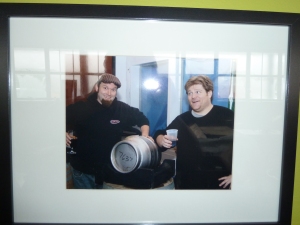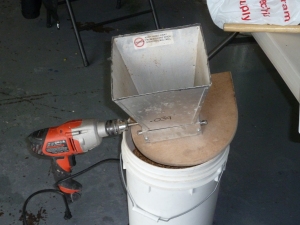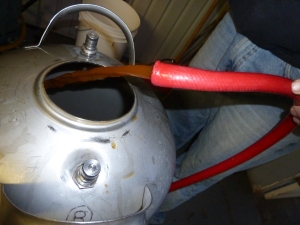If you’re an amateur brewer, you’re probably familiar with the phrase, “Relax! Have a homebrew.” I don’t know about you, but I don’t find this to be the comforting mantra that it is no doubt intended to be. In the back of my head when I’m brewing beer I’m mostly thinking, “Don’t screw up. Don’t screw up. Is everything sanitized? Oh crap! I’ve got to sanitize the airlock. The stuff is already in the bucket! It’ll all end in tears. Probably already has. Where the hell did I put the Star San?”
This is why it’s gratifying to work with Mike Lackey at Great Lakes. He’s the chillest of dudes; Even his goatee is laid back. Mike knows exactly what needs to happen at every step of the process. Instead of screwing around measuring star san into gallons of water, he’s just got a hose and what I have to assume is premeasured sanitizing solution.
At home, if I’m brewing a beer and I get to the step where I need to mash some specialty grains into it, there’s always that moment of trepidation when I look at the packages of malt and wonder whether the grain has been crushed yet. Several minutes of beating a towel full of malt with a 1.5 litre grolsch bottle or transferring grain in and out of the burr grinder ensue, and always with unsatisfactory results. Too big. Too small. I find myself either worrying about starch conversion or wondering why everything smells like the inside of Ideal Coffee.
Great Lakes has one of these, which gets everything the same size even if it does look like it would be more at home in a Saw film.
After the moderate success of the Breakfast Stout that I did with Great Lakes a couple of months ago, I was invited back to try again with a different recipe. Deciding what you’re going to brew in Ontario is easy; All you have to do is look at what there isn’t. We’ve sort of reached a point in Ontario where I don’t feel bad about taking US craft beers as inspiration since they’re so far ahead of us in so many different categories. This time around, I thought it would be fun to try an Old Ale. I know that’s a typically English style, but I figured that by throwing some American hops at it and keeping the malt slightly lighter than would usually be called for in terms of roast, we might be able to create something interesting. The inspiration for it was Great Divide Hibernation Ale.
BEHOLD! St.John’s Wort Old Drawing Board
Let me tell you, the name was more appropriate than I had initially anticipated. If you’re like me, you’ve got just enough knowledge about what is possible to end up with a recipe that pretty much ignores the probable. This is especially true when you’re working with the ingredients that are on hand at someone else’s brewery. (What? I’m going to complain about getting to use stuff for free when the alternative is buying everything myself and sanitizing bottles?) We didn’t have two varieties of Crystal, so we had to use American 70-80 Crystal Malt for both Crystal additions. We didn’t have Carastan, so we decided to use Melanoidin. We switched the Biscuit malt out for Cara. We did have all of the hop varieties that we needed. Nugget, Columbus and Styrian Goldings.
Brewing this way reminds me of a criticism I once got from my university music theory professor, who claimed that I tended to view the process of theory exercises not so much as an aesthetic pursuit, but as a crossword puzzle. I have a tendency to take a top-down view in recipe creation, choosing a style that I want rather than a flavour profile in order to create a beer. For that reason it’s great to work with the materials that are on hand in order to create something. It forces me to think about what the likely outcome is going to be and it forces me to make real choices instead of using ideal ingredients. The other fun part is that since I’m partially colorblind, SRM measurements mean relatively little to me. I don’t know what colour something is going to be even when my software displays a little coloured box.
In this case we ended up with a colour that I’m not sure I’ve seen before. As you can see, it’s sort of an opaque rust orange. Also, the Great Lakes pilot system has a conversion rate that’s slightly lower than the idealized 75% rate that my brewing software assumes.
What do you do when your dark brown, 8.7%, 93 IBU Old Ale ends up being rust orange, 8.0%, and about 107 IBU? Well, you realize pretty quickly that it’s not going to be an Old Ale. It’s not quite high enough in alcohol or dark enough in colour to be an American Barleywine. Imperial IPA? Maybe. All I can say is that I’m pretty sure it isn’t a Gruit or a Lambic. Add to this the fact that we might decide to age it in an Oak Barrel and the entire prospect becomes pretty frightening. We’re probably also going to have to come up with a new name. Agent Orange might dissuade people. Mr. Orange might narc on us. Orange Julius would be nice because of the colour and the Imperial nature of the beer, but I think there’s some copyright infringement to consider.
Maybe the best news to come out of the brew day is that the collaboration Lazarus Breakfast Stout is going to show up again over the course of the next couple of months. If you’ve tried it before, I’m hoping this hits you as good news. If you didn’t get to try it last time, it should be making its way to an establishment chock full of beer nerds near you. I was pleased to see some positive feedback on ratebeer for the Breakfast Stout. It’s not every day you’re judged to be overwhelmingly adequate by a jury of your peers.




It may not be a ‘true’ old ale, but the specs make it pretty similar to a Yorkshire Stingo.
Pingback: I Blush Yet Brag… I Brag And Yet I Blush… | Beer from Germany